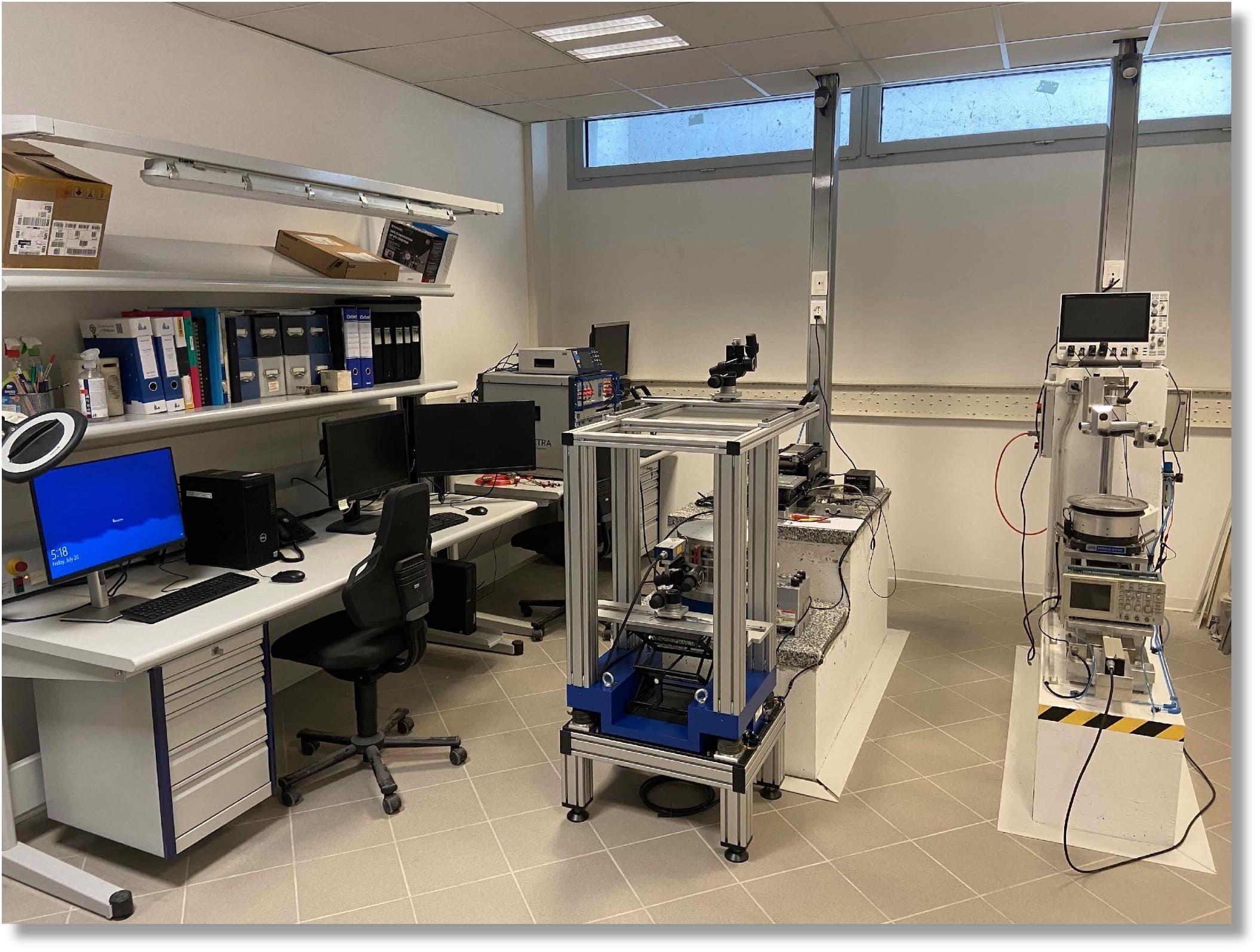The Seismological Calibration Centre is equipped with electronic systems for the verification and calibration of seismic acquisition equipment, also on behalf of third parties.
To ensure reliable and high-quality seismic monitoring, OGS must calibrate the sensors used in its seismometric networks. Calibration allows you to analyze the performance of the instruments, guaranteeing a report that documents their frequency response in amplitude and phase. This process is essential to:
- compare the actual characteristics of the sensor with those declared by the manufacturer;
- determine the specifications of new sensors, such as prototypes or newly developed devices;
- detect any changes over time due to sensor aging or malfunctions that are not visually evident.
To pursue these objectives, OGS has established the Seismological Calibration Centre, equipped with a laboratory (ShakeLab) set up at the Centre for Seismological Research (CRS) in the Udine headquarters. The laboratory is equipped with three shaking tables which, through primary and/or secondary procedures, allow to determine the frequency response (modulus and phase) of the sensors under test. Shaking tables are tools designed to reproduce controlled oscillations and simulate the effects of an earthquake. Furthermore, they can measure these effects using both a reference sensor and the sensor to be examined, thus ensuring accuracy and precision in calibration.
In primary calibration systems, a laser device precisely measures the position of the velocimeters and/or accelerometers to be examined. The laser signal, derived once or twice depending on the type of sensor, is compared with the signal produced by the sensor itself. The ratio between the spectra of the two signals is used to determine the frequency response of the sensor.
In secondary calibration systems, however, the reference signal is provided by an accelerometer calibrated by the manufacturer. By following procedures like those used in primary calibration, the frequency response of the tested sensors is obtained. However, using a reference accelerometer, rather than the laser, makes the system more sensitive to noise, reducing the quality of the result.
Presented below are the three shake tables, along with descriptions of their distinctive features, which enable the Center to operate across various sectors and applications:
The TVO is an equipment entirely designed and built by CRS staff, with continuous development that makes it suitable for the calibration of new experimental sensors. The SPEKTRA shake table, recently acquired thanks to funds from the PNRR ITINERIS project, allows for calibrations compliant with two specific ISO standards. Finally, the ATOM shake table, thanks to its compact dimensions and low weight, is easily transportable and usable in outdoor environments, making it ideal for the calibration of GNSS instruments, which requires direct visibility of satellite constellations.
Prospects point to both technological development and the provision of dedicated services to the public sector, including the European seismological and geodetic communities, and to the private sector. To achieve these objectives, the main steps to be taken include: the accreditation of the SPEKTRA shake table by Accredia, the activation of standardized procedures for the calibration of GNSS systems using the ATOM shake table and the integration of the calibration services offered from OGS, with all available shake tables, in European research networks and services, such as Transnational Access (TNA).
Furthermore, OGS aims to develop new technological solutions for TVO, integrating them with products already available on the market, such as the SPEKTRA shakie table. In this context, the Seismological Calibration Center represents an ideal environment for innovation, encouraging interaction among different technologies and promoting collaboration between the public and private sectors.
Acknowledgments:
The SPEKTRA Vibrating Table was realized with funds from the European Union – Next Generation EU – Mission 4, "Education and Research" – Component 2, “From Research to Business” – Investment Line 3.1, "Fund for the realization of an integrated system of research and innovation infrastructures" – Project IR0000032 – ITINERIS - Italian Integrated Environmental Research Infrastructures System – CUP B53C22002150006.
References:
- D. Zuliani, A. Compagno, E. Del Negro, M. Bertoni, P. Di Bartolomeo, H. Siracusa, P. Ziani, G. Capotosti, G. Rossi, P. Bragato, M. Picozzi (2024). Centro di Taratura Sismologico di OGS, VIII Forum Nazionale delle Misure, Garden Toscana Resort - San Vincenzo / 12-14 Settembre 2024, presentazione, DOI: 10.13140/RG.2.2.17479.92322;
- D. Zuliani, A. Compagno (2024) Il Centro di Taratura Sismologico di OGS, TUTTO_MISURE, Anno XXCI, N. 03 2024, GMEE Associazione Italiana Gruppo di Misure Elettriche ed Elettroniche ed., https://issuu.com/tutto_misure/docs/tm.3-2024;
- D. Zuliani, E. Del Negro, M. Bertoni, A. Compagno, P. Di Bartolomeo (2022). Taratura dell’accelerometro Lunitek: modello LTFB-160, 2022/91 Sez CRS 14, dd. 13/06/2022;
- D. Zuliani (2017). Taratura di un accelerometro Columbia FBA e di un sismometro Lunitek LT-3D-1 per Lunitek s.r.l., 2012/27 Sez CRS 7, dd. 31/03/2017;
- D. Zuliani, E. Diez (2012). Taratura anno 2011 dei sismometri short-period della Rete Sismometrica del Friuli-Venezia Giulia, 2012/7 CRS 2 INTA, dd. 23/2/2012, DOI: 10.13140/RG.2.1.4910.5044
- D. Zuliani, F. Ponton (2008). Taratura di sismometri modello LE-3D/5S dell’Istituto Nazionale di Geofisica e Vulcanologia INGV, Rel. OGS-038/2008/CRS-003 13 marzo 2008;
- David Zuliani, Eduardo R. Diez Zaldivar, Fausto Ponton (2007). VIBROCALC, SEISMOMETER FREQUENCY RESPONSE ELABORATION SOFTWARE, IC/IR/2007/004 Internal Report, for “The Abdus Salam International Center for Theoretical Physics – ICTP”, dicembre 2007, DOI: 10.13140/RG.2.1.2514.3444
- Eduardo R. Diez Zaldivar, David Zuliani and Fausto Ponton (2006) CUBAN SEISMIC NETWORK SHORT PERIOD SEISMOMETER CALIBRATION, IC/IR/2006/006 Internal Report for “The Abdus Salam International Center for Theoretical Physiscs – ICTP”, dicembre 2006, DOI: 10.13140/RG.2.1.3825.0649;
- D. Zuliani, E. Diez (2006). VIBROCALC Relazione tecnica: Seismic sensor frequency response elaboration software, Rel. OGS-076/2006/CRS-017 29 agosto 2006, 10.13140/RG.2.1.4566.4408;
- F. PONTON, P. DI BARTOLOMEO, D. ZULIANI, E. DIEZ (2005). Shaking table, CENTRO DI RICERCHE SISMOLOGICHE DEPARTMENT OF SEISMOLOGY 2005 ANNUAL REPORT, 2005, 38-40pp;
- F. PONTON, P. DI BARTOLOMEO, D. ZULIANI (2004). Shaking table, CENTRO DI RICERCHE SISMOLOGICHE DEPARTMENT OF SEISMOLOGY 2004 ANNUAL REPORT, 2004, 39-41pp;

